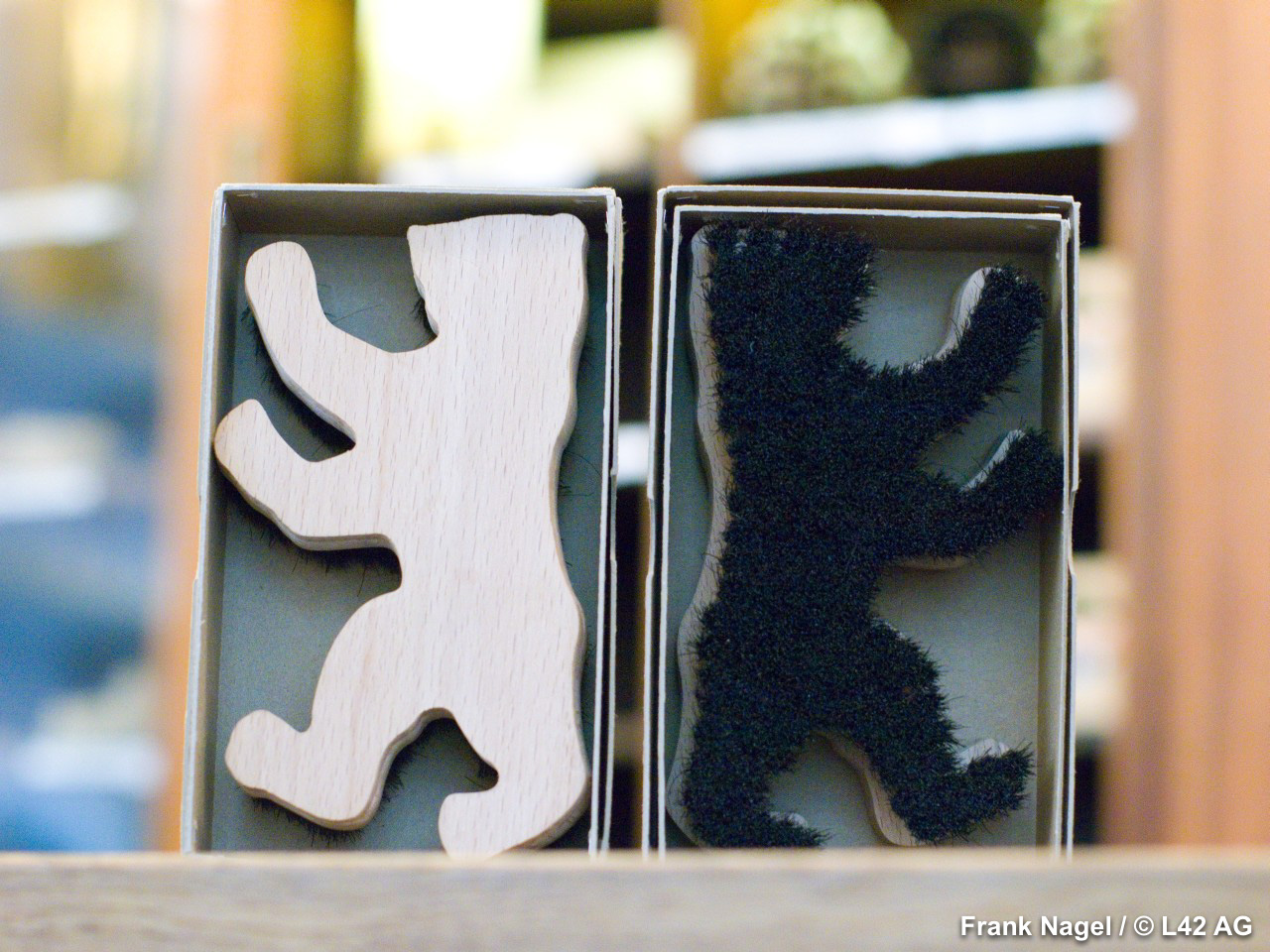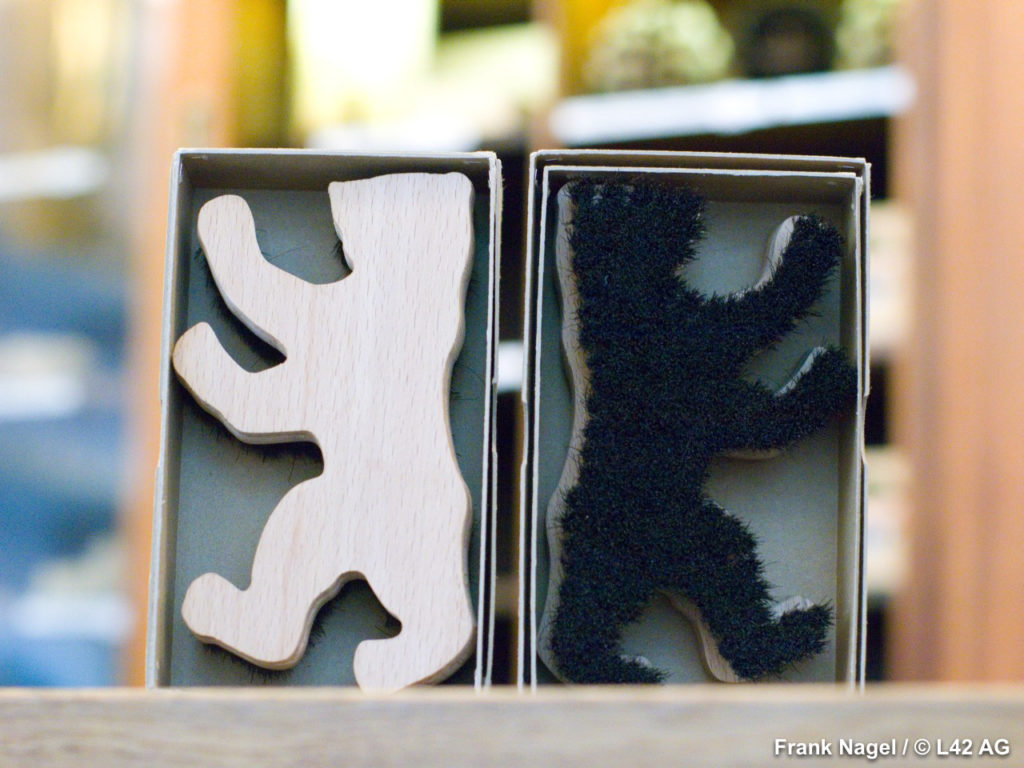
Kreuzberg is more than a neighborhood. Whenever someone mentions Kreuzberg, they usually mean something else, and, quite often, they mean a problem. In order to attempt to construct an idea of the concept of Kreuzberg we would have to get a group of stereotypes and clichés together that could possibly describe it, stitch them together, and hope that the description would in some way hold. And yet, many people seem to think that every time you want to undertake anything at all in Kreuzberg, even simply a conversation, the fiery residents get fired up and begin to start collecting signatures with which to say “No way! Enough! Not going to happen!” If Berlin is a young city, Kreuzberg is often considered the eternal adolescent, slamming doors to affirm its identity. With every generation we see a slightly different Kreuzberg, but one that’s always “against.”
One of Kreuzberg’s biggest problems today is a little imported capitalistic drug called “gentrification.” The neighborhood has indeed become a bit more bourgeois thanks to all the real-estate speculation over the last number of years, which has raised the price of apartments and, as a result, many of the most important smells have disappeared from many of its streets along with a good part of its former residents. And yet, Kreuzberg resists. Though it may have ceded Bergmannstraße and its surrounding streets to the more well-to-do and has since moved on toward Neukölln, it hasn’t given up. And even if, in reality, Neukölln too has seen a continuous increase in prices, something tells us that Neukölln won’t give up without a fight either.
In our case, resistance is armed with fragrances. Kreuzberg-Neukölln, also sometimes known as Kreuzkölln, is primarily a working-class area, or what’s known as a “multikulti” area (“multi-cultural”) on account of the more than two hundred or so ethnic minority groups that call it home. More than anything else, however, it is primarily Turkish. In Kreuzberg both work and cuisine are of a rather distinct Middle Eastern flavor and, from an aromatic point of view, extremely interesting. There are of course people who aren’t of a Middle Eastern background who have moved to Kreuzkölln, but who also have every interest in resisting. If Mitte, Prenzlauer Berg, and a fair amount of Friedrichshain – all parts of former East Berlin and now floating about ten feet off the ground, which is to say, having taken on airs – seemed headed toward a less diverse future, Kreuzkölln today remains the true torchbearer of olfactory resistance.
In Kreuzkölln there are canals that in summer give off an intense smell of, well, canal, and every Tuesday and Friday there is the Turkish market on the Maybachufer. Then there are the tea lounges where there is also a lot of cigarette and nargile (hookah) smoking, and after that come all the places roasting all kinds of meat.
In Kreuzkölln we will sniff about the air of Oranienstraße and the Kottbusser Tor U-Bahn station and compare them to the quite different air to be found, for example, in Mitte’s quite similar-sounding Oranienburger Straße. We’ll hop on the U1 at Uhlandstraße and ride the elevated rails over to Kottbusser Tor (careful, however, not to do so during May Day demonstrations). For our part, armed with paper and pen, this time we’ll take physical note of every smell that we encounter. However, at the moment, we seem to be in the middle of an apocalyptic landscape and there’s nothing to smell at all. The U-Bahn is meandering on along its way, but below us there’s a terrible intersection of streets that’s completely full of traffic. Down on the stairs leading away from the tracks there even seems to be a discrete bit of a traffic of a different kind. From the shadows of the pillars along the station platforms wafts the acrid stench of urine.
Well, it seems like we’re in the right place but all of the sudden our nose seems to close up and begins to tremble, vibrating in time with the pneumatic hammer that’s breaking up the asphalt in order to lay down a new road surface. If there’s new road to be laid then there’ll be a cement mixer, a tar kettle, something yummy to smell! But, no, there’s nothing. The cars are trembling at their traffic lights in the traffic circle and we continue to tremble along with the hammer. Our nose doesn’t seem to be working at all anymore. We’ve all simply become part of the general soundwaves. Ubi maior minor cessat. We have got to get out of here! We’ll take the Adalbertstraße and immediately duck into the best of the Turkish restaurants around: Hasir. Meats and vegetables smolder on coals and from the gigantic spit comes only the smell of authenticity and quality. Peppers, onions, and raw cabbage are exhibited in the display case and from the kitchen arrives the wonderful smell of bean soup.
At the corner with Oranienstraße we’ll turn to the right and immediately step into the antiquarian bookshop at 28A. The first thing we notice is that used books smell more like paper than glue and this smell reminds us a bit of public libraries or even private ones, while the no-less-fascinating bookshop at Number 25 has a lovely smell of heavily trod carpet and heaps of glossy books that simply smell, well, like new books. The Spartan but well-stocked bookshop at Number 21 smells like paper and cigarette smoke. The books of a definite smoker, but also a serious scholar. The comic book shop at Number 22 has two smells: glue from the shelves where there are the latest issues, and paper from those with the old and black and white ones. The smell of comics, however, is different from that of books. Maybe the type of glue is different. Here the smell in some of the corners is exactly the same one you loved as a child when tearing open baseball card packs in another part of the world, before you had any idea of what it might have been. And here it is once again. Let’s linger a little while longer. Among the dolls from the Far East there’s an extremely sour scent of gas that has to come from the plastic.
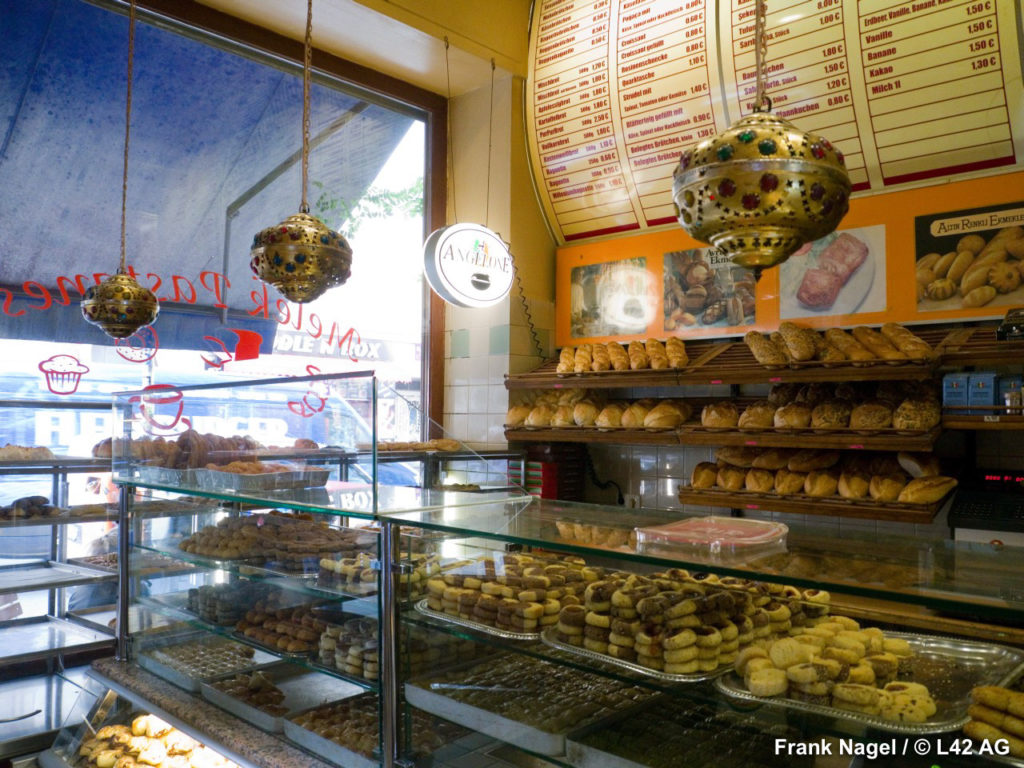
At Number 28 there’s a Turkish bakery with oven, laboratory, and great mound of bread and sweets mixed together giving off a smell and sense of simple abundance. The aromas are unmistakably Mediterranean: there’s some olive bread, a lot of sesame seeds, pistachios, almonds, and honey. At 27A there’s a huge tea hall, Smyrna Kuruyemis, which means “The Walnuts of Smyrna”, a pastry shop that also sells lots of different types of seeds, something which is quite common. For the most part, Turks of all ages come here, preferably divided by gender, and the men look at the women and the women look at their mobile phones, and all of them are drinking tea and munching away at industrial amounts of pistachios, almonds, nuts, peanuts, cashews, pumpkin seeds, sunflower seeds, toasted corn, chickpeas, and toasted fava beans either covered in paprika or plain. There is a slight, toasted smell and the continual chic-chic of pumpkin and sunflower seeds being opened with people’s teeth. People are dragging chairs, talking, and laughing out loud and no one’s in any danger of bothering anyone else. In back there’s a room for smokers, but the door opens and closes continuously so it smells like smoke throughout the entire hall. The clientele is completely Turkish as are all the writings. “Kahve fali bakilir” it says at the checkout and “Eleman araniyor” is written over the door and even if they were simply help-ads for a waiter, they wouldn’t be for everyone. Whoever loves sweets will immediately recognize that breath of vanilla sugar and honey that comes from the figs, from the dates, the walnuts, the coconut, and the almonds mixed in the most varied of ways, covered in sesame, in long sticks like nougat or simply in the guise of confetti and candied fruit. There in a basket you’ll find the aromatic herbs: sage, cinnamon, chamomile, mint, ginger, and lime flowers. An aromatically delightful and lively place, there’s nothing else to say!
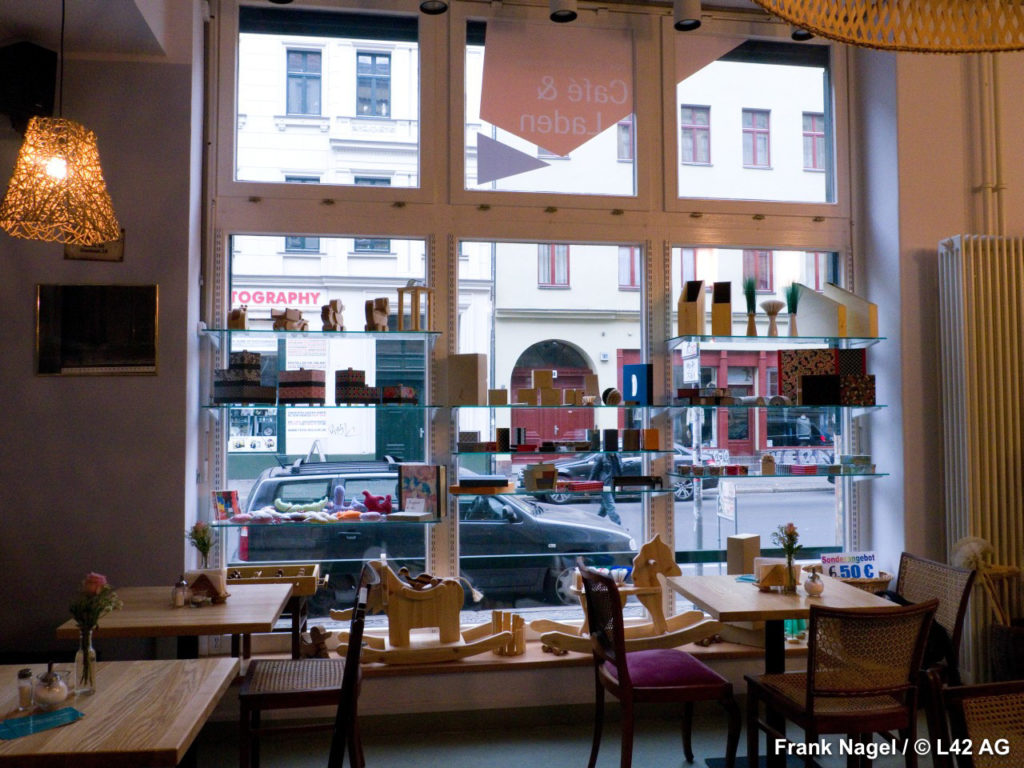
One of the most singular airs of Berlin can be found at Number 26, the workshop and café of the USE, the Union Sozialer Einrichtungen, a gGmbH company, which is to say, a company which must reinvest all of its profits to the advantage of its workers and which employs around 150 physically or mentally disadvantaged workers who are coordinated by a team of around thirty educators, psychologists, and production and commercial managers. Here they produce ceramics, books, paper and cardboard boxes, wooden objects, pictures, and fabrics; they recover chairs; they make flower arrangements; and, finally, they produce brushes and brooms from mostly natural materials. For just the little bit of money you have in your pocket you can buy some truly special objects. The folks in the brush and broom workshop, for example, have worked together with designers in order to invent not only little brushes in the form of bears or the Brandenburg Gate, but environmentally friendly pipe-cleaners to clean out beer bottles which double as rather refined and economical Christmas trees as well…The duster smells like goat and so we’ve just got to ask “Sorry, but is this used to clean goats, or is it simply made from goat hair?” The reply: “Well, it comes from a long-haired Chinese goat. And see this one? This broom is made of horsehair, this big brush right here from Chinese pig hair, these little ones from coconut fiber, and for these other ones here we use the strong Mexican agave which has been used since the time of the Conquistadors to insulate ships…” Never in a million years would we have imagined that we might encounter something like this here in Berlin: suddenly we can smell the Conquistadors’ boats, concentrate on the dry, exotic, and woody essence of coconut shells…and the horsehair here smells less intensely than the horse blankets in Grunewald because the fibers of the horsehair are more compact and allow less sweat and other organic liquids from the animals to penetrate…
Question: “Sorry, but the plastic brooms…”
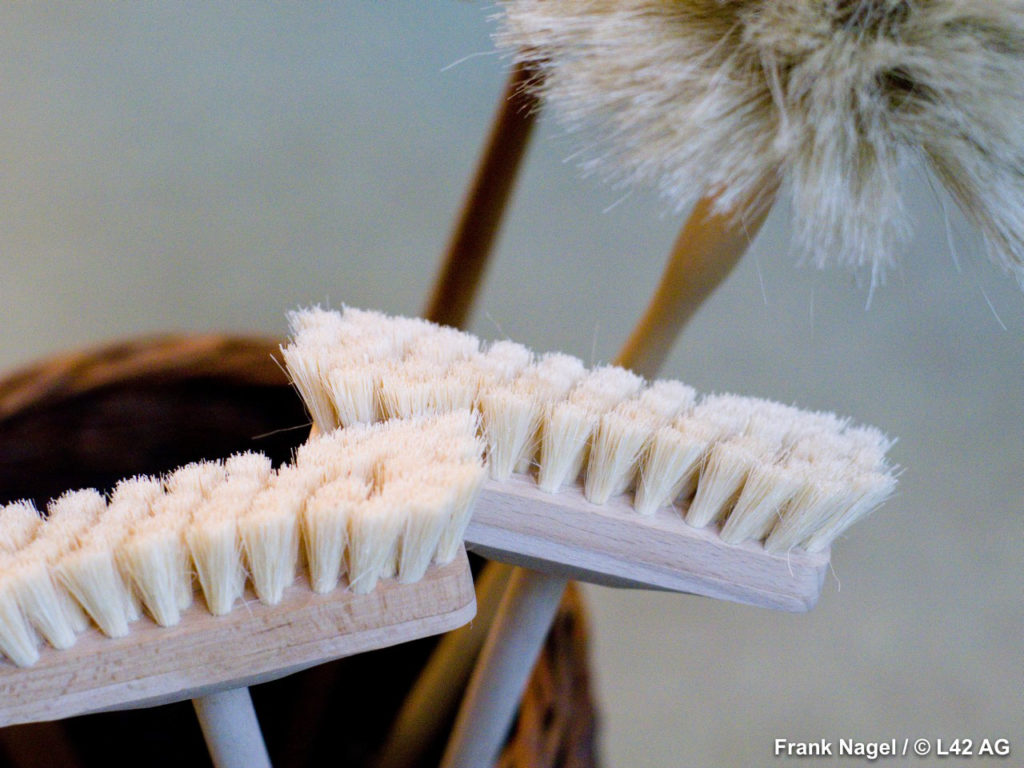
Answer: “We don’t make any plastic brooms. By tradition, our workers, who for the most part are blind and are cognitively impaired, work only with all natural fibers. You have to imagine that when a batch of fur arrives here from who knows what distant country our workers can detect even the slightest odor of whatever petroleum they used to kill parasites that even our rigorous quality control somehow managed to miss. You know what they say? ‘You can work with this crap yourself!’” (Cognitive impairment aside, these are true workers from Kreuzberg!)
Question: “And do your brooms last longer?”
Answer: “Our brooms enjoy a long life because they always breathe. They should always be placed with their heads in the air, see? Like this. Otherwise they get bent and broken and suffer.”
Question: “So, this is a workshop where high-quality, all-natural products are made, you breathe healthy air, and you work harmoniously…”
Answer:” This is a place where one hundred and fifty people with congenital or acquired difficulties find a place to express themselves through their work. This doesn’t mean that it’s always simple. Everyone has their limits, people argue sometimes, or become discouraged, or are overcome by their emotions…”
We thank them and go upon our way, but not before picking up a pipe-cleaner/Christmas tree. Even if it’s not quite the right season the little tree is, of course, evergreen and anyway can be used throughout the year to clean glasses and, above all, to remind us of the atmosphere here at Oranienstraße 26. As such, it will give us more oxygen than we ever imagined.
Another extremely interesting place to visit is Green Fuzz, located at 23A, a kind of bazaar that, in addition to shoes, economically-priced bags of various materials, and various accessories, sells clothes which in other places would be called “alternative” but here are really quite normal. In just such a place you usually manage to encounter the smells of the former inhabitants and following in the wake you arrive before a row of well-made and sturdy shoes that smell of real leather and real suede and which only cost 10 euros. What? How is that possible? It’s possible thanks to their odd sizes and the fact that they’re last year’s models. A great deal of a product’s price is decided by marketing and the law of supply and demand and the nose just isn’t taken into consideration.
We’ll go in to Number 23 to see whether amid all those balls of wool you can still smell the sheep. As a matter of fact, the wool that still contains lanolin, the animal fat, does smell strongly of sheep and after you touch it, will leave your fingers slightly greasy. In second place, we have the uncolored wool. Surprisingly, even the almost florescent wool retains some of the characteristic odor. Incredible, even the sheep in Kreuzberg have character! Here they sell both pure balls of wool as well as those made in silk. And the silk has its own odor, too. It smells a little bit fresh, a little bit bitter, a little bit like bark…
But now it’s time to cross the street in order to stop by the HanfHaus at Number 192. Going inside the “Hemp House” (with who knows what kind of preconceptions in our minds) the only smell that even remotely reminds us of the smokable variety comes from a shampoo. Hemp is a natural fiber which, contrary to what most people think, has almost no smell whatsoever because it is almost entirely resistant to bacteria. For this reason it absorbs sweat and is a good defense against the smells which come from perspiration. The hemp plant grows extremely fast: 4 meters (approximately 13 feet) in about 4 months, and it contains cellulose which could make it an alternative source of paper. But let’s cross back over the street.
At Number 20 there’s a tiny little historical market which specializes in salumi and cheeses from all over, but, especially, the French, Italian, and German varieties. Here there the smell of smoke predominates: salami and scamorza. But don’t even think of saying it reminds you of KaDeWe! That’s offensive! That stated, it’s probably equally offensive to maintain the opposite. Not only does Kreuzberg pride itself on not being Schöneberg, but it probably gets its hackles up just at the thought of Schöneberg.
By this point you’ve probably already asked yourself a few times as to whether our sniffing around really makes any sense at all. And each and every time we’ve managed to reassure you that, yes, we’re on the right path, we’re simply following along one of those paths of awareness that takes the side streets. The direction’s still the same: true awareness (even if, truth be told, we haven’t quite reached enlightenment just yet). We’re busy contemplating various smells and meeting people, just like the scientist who every day humbly repeats the same measurements, year in, year out, and then, all of the sudden…eureka!
And this word escapes our lips too when we arrive at Number 19A. Here there’s a woodworker who works with pine, oak, and beech and you can smell it. Then there’s the workshop from Zentralrad, literally “central wheel,” the proud bicycle shop for the whole neighborhood which proudly and strongly smells of the rubber used for tires and oil. From the courtyard’s flowerbeds comes the smell of oregano and with it the smell of coal-fired heating, which some of the residents here still use but is now one of the most precious olfactory memories of when all of Berlin was heated this way. However, that’s not all. There’s also a pipe coming out from a pizzeria which is busily puffing away and, above all, Propolis, the all-natural paint shop for artists, open Tuesday to Friday from one p.m. to seven p.m. and Saturday morning from 11 a.m. to 2 p.m. Though the name might make you think it’s a typical New Age shop, there’s nothing New Age about Propolis at all.
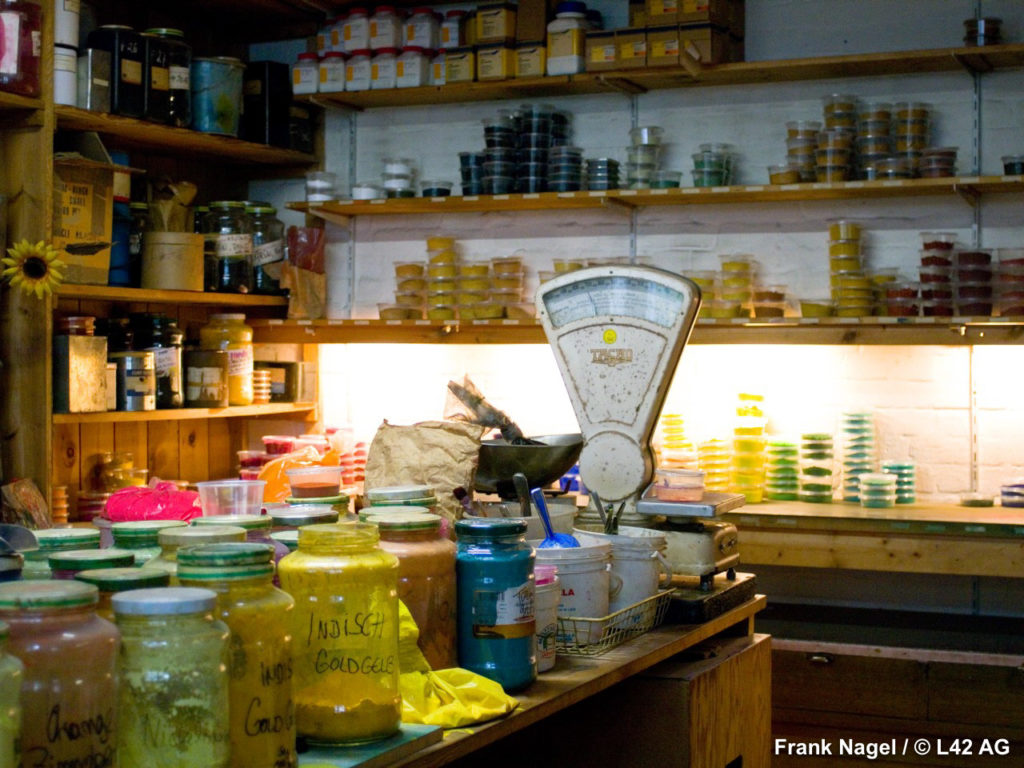
You enter in through one of the Altbau’s (literally “old building”, typically built around the turn of the 20th century) ragged stairwells – unlike those in Mitte or Prenzlauer Berg, most of them haven’t been renovated here – and then, careful not to trip over the steps, you come into this other world that’s like stepping through a magic mirror. We’re not only changing metaphorical gears here, but dimensions, and we’re right about to make one of the most incredible discoveries that our research could ever offer. We have come to realize that a smell, an odor, not only has to do with the here and now, but that it has a long history and life behind it; furthermore, it is capable of mixing together and living with other smells in order to construct a three-dimensional olfactory society. Here in Propolis we encounter both the history and the society of essences. It’s not like moving around in a large library where knowledge has been organized and cataloged; rather, it is a process of continual engagement with the different aromatic characters of various materials and visitors. The different smells come and go from the shelves and ride as they like through space and time. Unfortunately, nature hasn’t conceded as much to books, poor things.
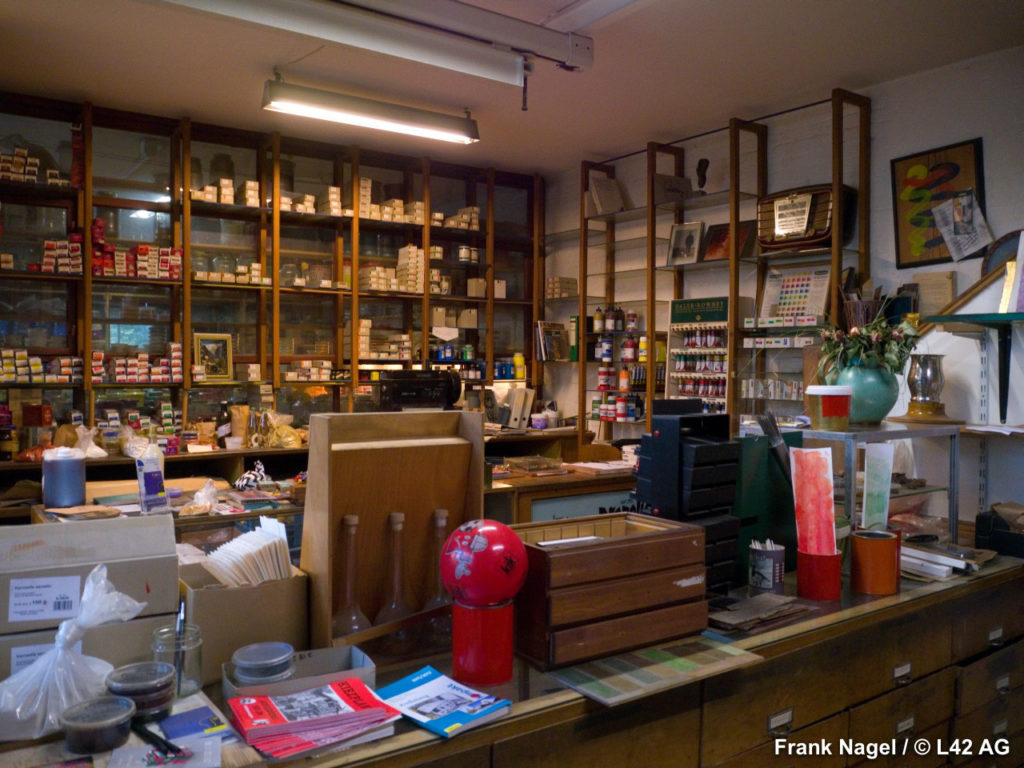
Propolis escapes any definition, but for more than thirty years has collected more than 240 pigments and more than one thousand materials and all of them live side by side in a spontaneous way. This laboratory is really a place of the soul and can be experienced on different levels. Whoever comes with the gift of sight remains impressed, above all, by the amount of colored pigments strewn all over the place closed up in little glass jars or in plastic bags. The shelves and mainly wooden drawers are literally overflowing with things for painting. Canvases and frames line the walls and everywhere there are artworks and recovered objects turned into artworks nonchalantly lying about. There’s nothing austere about the old books, precious ampules, or dark glass bottles; on the contrary, they exert a happy authority we’d gladly and immediately like to learn from. Not a single thing here has been ordered, straightened out, or dusted. No one here has ever even considered wasting time and energy in those boring bourgeois pastimes like cleaning the windows, mopping the floor, or, horror of horrors, employing that modern monster of the vacuum cleaner. And yet, the air here in this marvelous chaos without a doubt is the best in all of Berlin.
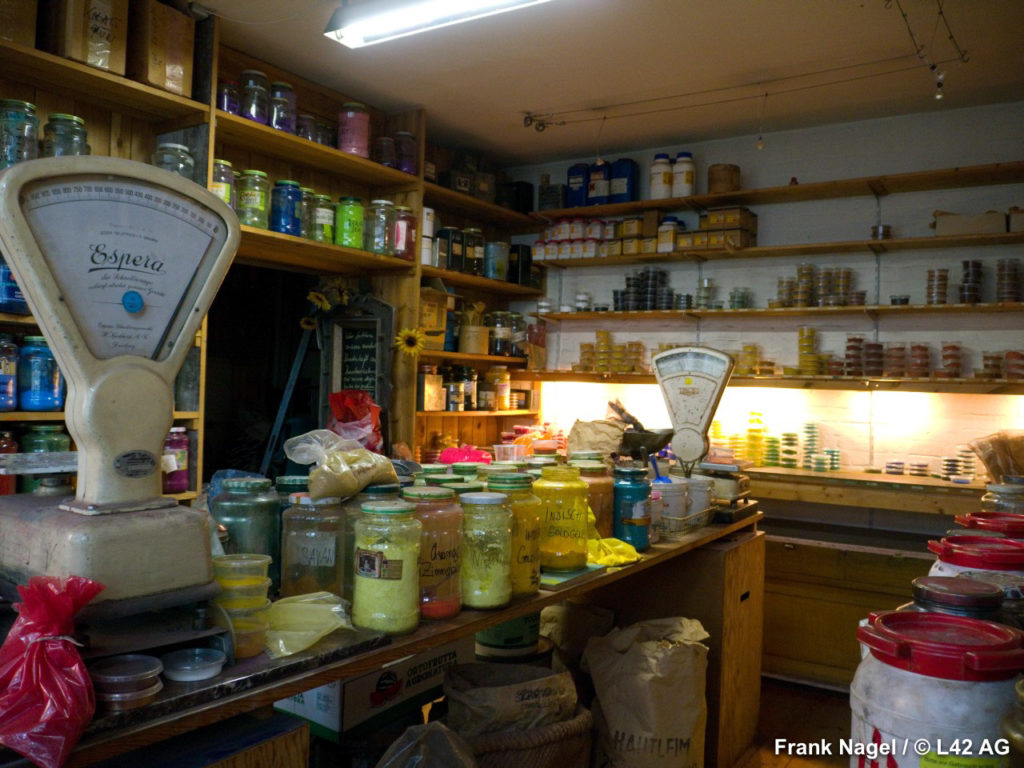
The dust is not simply vulgar filth here: every single, extremely fine mote has a name and a role and it’s like you were breathing in the air of those old physics or chemistry labs in the oldest of science departments. Suddenly, from a corner comes the sweet smell of beeswax, then, from another, the cloyingly fruity smell of crushed cellulose, and in another a cloud of gesso, from a jar of pigments an aroma of essential oils comes out. The secret to this harmony likely lies in the perfect mixture between artist’s intuition, nature, culture, freedom, and time. The order here is mental and of a higher nature and vibrates along frequencies that are difficult to explain, but intuitively intelligible. The essences and the objects are simply left alone to express themselves and, as we are dealing with elements of quality, their conversation is always wide-ranging and enjoyable. The essential oils have been bottled up, true, but they once were open and their fragrances were therefore able to spread and the memory of their passing continues to vibrate through the air which, depending on the temperature, sometimes allows this one to speak, sometimes that one. If there is an olfactory paradise on the earth, it is represented by essential oils and thus a large part of that paradise is right here. You’d need at least a day’s time to sniff about in here, filling a notebook up with impressions, dreams, and memories before coming back the next day in order to once again smell the world and love it in all its harmonious complexity. © L42 AG
Translated by Alexander Booth
